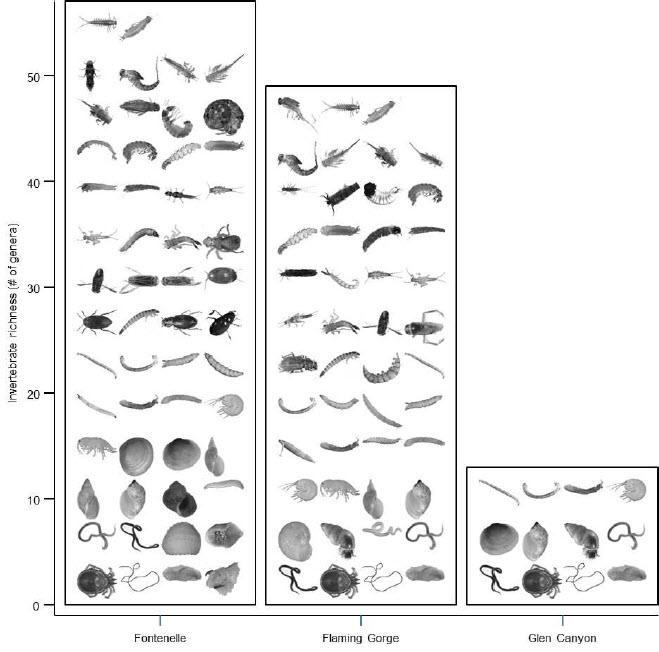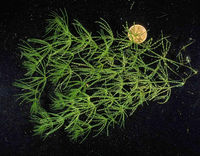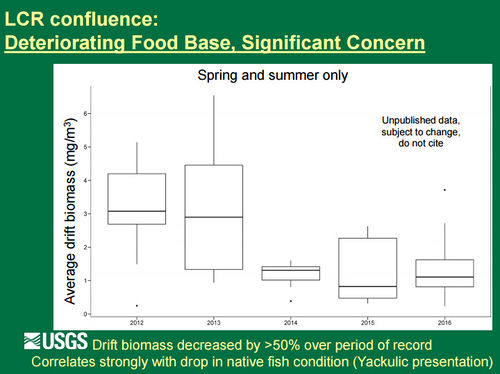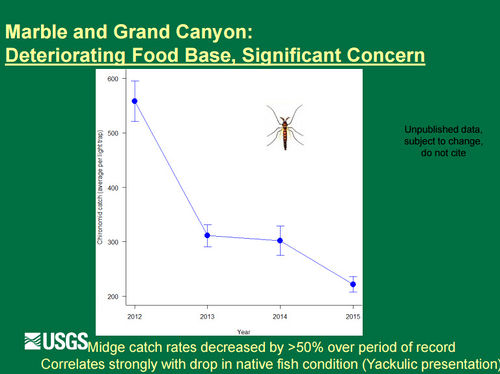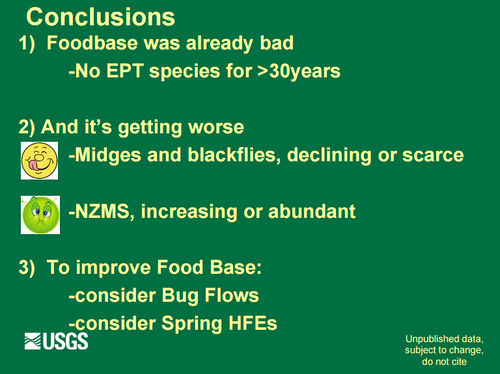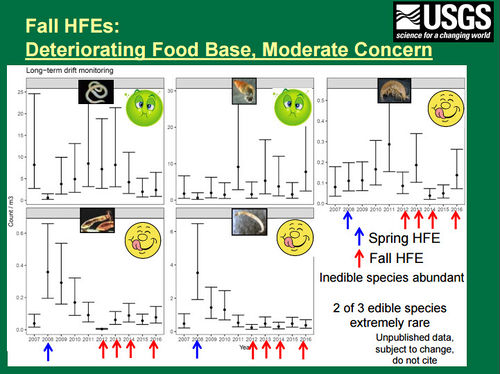Difference between revisions of "FOOD BASE"
Cellsworth (Talk | contribs) |
Cellsworth (Talk | contribs) |
||
| Line 219: | Line 219: | ||
===The interaction of fish, foodbase, and temperature=== | ===The interaction of fish, foodbase, and temperature=== | ||
Fish occupying warmer water have higher metabolic demands than individuals in cooler water, and if these demands increase concurrently with a seasonal decline in prey availability, then growth rates may be reduced. [http://wec.ufl.edu/floridarivers/NSE/Finch%20RRA%20HBC%20Growth%20NSE.pdf] | Fish occupying warmer water have higher metabolic demands than individuals in cooler water, and if these demands increase concurrently with a seasonal decline in prey availability, then growth rates may be reduced. [http://wec.ufl.edu/floridarivers/NSE/Finch%20RRA%20HBC%20Growth%20NSE.pdf] | ||
| + | |||
| + | ---- | ||
*Black Flies and Midges fuel fish production below Glen Canyon Dam. | *Black Flies and Midges fuel fish production below Glen Canyon Dam. | ||
| Line 224: | Line 226: | ||
*Mud Snails were introduced below Glen Canyon Dam around 1995. | *Mud Snails were introduced below Glen Canyon Dam around 1995. | ||
| − | + | ---- | |
| + | |||
| + | Notably, several species of cold-tolerant nonnative invertebrates were intentionally introduced into the Colorado River after Glen Canyon Dam was closed in 1963. Altogether 10,000 immature mayflies were secured from a commercial source in Minnesota and released at three sites in the Lees Ferry reach. Also, 10,000 snails, 5,000 leeches, and thousands of insects representing at least 10 families were transported from the San Juan River in New Mexico to the river near Lees Ferry. In addition, 50,000 “scuds” (Gammarus lacustris) were introduced into Bright Angel Creek in 1932 and at Lees Ferry and below the dam in 1968, in addition to 2,000 crayfish taken from the LCR near Springerville, AZ (Blinn and Cole 1991). Gammarus lacustris has thrived in the cold, clear reaches below the dam, but the fate of the other introduced species is unknown. | ||
|} | |} | ||
Revision as of 15:02, 11 July 2018
|
|
The Aquatic Food Base below Glen Canyon DamThe Colorado River below Glen Canyon Dam has been altered by dam-induced modifications to the river’s flow, temperature, and sediment supply. Nonnative species have also changed the natural system. Nonnative fish are thought to prey on and compete with native fish, including the endangered humpback chub (Gila cypha). These impacts have likely changed both the amount and sources of energy that fuel the aquatic food web and the flows of energy within the food web. Installation of the dam created a relatively clear, cool aquatic environment below the dam that now allows aquatic plants to capture the sun’s energy, and they in turn are now consumed by a few species, including scuds (Gammarus lacustris), midges (Family: Chironomidae), blackflies (Simulium arcticum), and New Zealand mudsnails (Potamopyrgus antipodarum). The first three species can provide food for both native and nonnative fishes, but fish cannot digest the New Zealand mudsnail. Desired Future Condition for the Aquatic Food BaseThe aquatic food base will sustainably support viable populations of desired species at all trophic levels. Assure that an adequate, diverse, productive aquatic foodbase exists for fish and other aquatic and terrestrial species that depend on those food resources. |
| EPT as Biologic Indicators of Stream Condition |
Algae and Aquatic Macrophytes |
Aquatic Macroinvertebrates |
|---|
